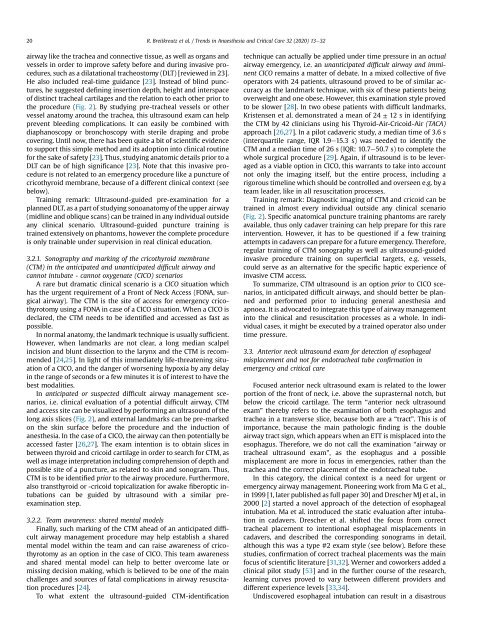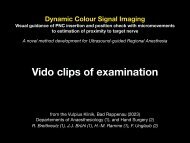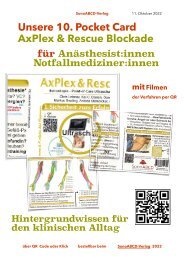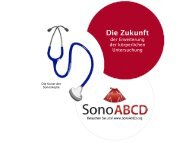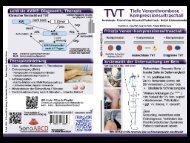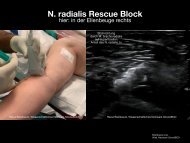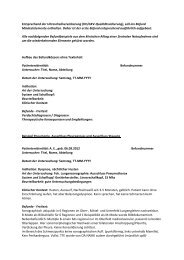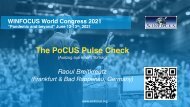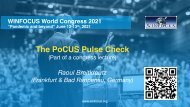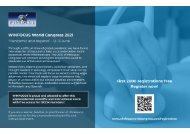Anterior Neck and Airway Ultrasound - a practical overview.
A narrative review. Video clips on our site as well. It is available online at publisher´s site: https://authors.elsevier.com/a/1b66X7si0yR9sx as editor´s pick free of charges.
A narrative review. Video clips on our site as well. It is available online at publisher´s site: https://authors.elsevier.com/a/1b66X7si0yR9sx as editor´s pick free of charges.
Create successful ePaper yourself
Turn your PDF publications into a flip-book with our unique Google optimized e-Paper software.
20<br />
R. Breitkreutz et al. / Trends in Anaesthesia <strong>and</strong> Critical Care 32 (2020) 13e32<br />
airway like the trachea <strong>and</strong> connective tissue, as well as organs <strong>and</strong><br />
vessels in order to improve safety before <strong>and</strong> during invasive procedures,<br />
such as a dilatational tracheostomy (DLT) [reviewed in 23].<br />
He also included real-time guidance [23]. Instead of blind punctures,<br />
he suggested defining insertion depth, height <strong>and</strong> interspace<br />
of distinct tracheal cartilages <strong>and</strong> the relation to each other prior to<br />
the procedure (Fig. 2). By studying pre-tracheal vessels or other<br />
vessel anatomy around the trachea, this ultrasound exam can help<br />
prevent bleeding complications. It can easily be combined with<br />
diaphanoscopy or bronchoscopy with sterile draping <strong>and</strong> probe<br />
covering. Until now, there has been quite a bit of scientific evidence<br />
to support this simple method <strong>and</strong> its adoption into clinical routine<br />
for the sake of safety [23]. Thus, studying anatomic details prior to a<br />
DLT can be of high significance [23]. Note that this invasive procedure<br />
is not related to an emergency procedure like a puncture of<br />
cricothyroid membrane, because of a different clinical context (see<br />
below).<br />
Training remark: <strong>Ultrasound</strong>-guided pre-examination for a<br />
planned DLT, as a part of studying sonoanatomy of the upper airway<br />
(midline <strong>and</strong> oblique scans) can be trained in any individual outside<br />
any clinical scenario. <strong>Ultrasound</strong>-guided puncture training is<br />
trained extensively on phantoms, however the complete procedure<br />
is only trainable under supervision in real clinical education.<br />
3.2.1. Sonography <strong>and</strong> marking of the cricothyroid membrane<br />
(CTM) in the anticipated <strong>and</strong> unanticipated difficult airway <strong>and</strong><br />
cannot intubate - cannot oxygenate (CICO) scenarios<br />
A rare but dramatic clinical scenario is a CICO situation which<br />
has the urgent requirement of a Front of <strong>Neck</strong> Access (FONA, surgical<br />
airway). The CTM is the site of access for emergency cricothyrotomy<br />
using a FONA in case of a CICO situation. When a CICO is<br />
declared, the CTM needs to be identified <strong>and</strong> accessed as fast as<br />
possible.<br />
In normal anatomy, the l<strong>and</strong>mark technique is usually sufficient.<br />
However, when l<strong>and</strong>marks are not clear, a long median scalpel<br />
incision <strong>and</strong> blunt dissection to the larynx <strong>and</strong> the CTM is recommended<br />
[24,25]. In light of this immediately life-threatening situation<br />
of a CICO, <strong>and</strong> the danger of worsening hypoxia by any delay<br />
in the range of seconds or a few minutes it is of interest to have the<br />
best modalities.<br />
In anticipated or suspected difficult airway management scenarios,<br />
i.e. clinical evaluation of a potential difficult airway, CTM<br />
<strong>and</strong> access site can be visualized by performing an ultrasound of the<br />
long axis slices (Fig. 2), <strong>and</strong> external l<strong>and</strong>marks can be pre-marked<br />
on the skin surface before the procedure <strong>and</strong> the induction of<br />
anesthesia. In the case of a CICO, the airway can then potentially be<br />
accessed faster [26,27]. The exam intention is to obtain slices in<br />
between thyroid <strong>and</strong> cricoid cartilage in order to search for CTM, as<br />
well as image interpretation including comprehension of depth <strong>and</strong><br />
possible site of a puncture, as related to skin <strong>and</strong> sonogram. Thus,<br />
CTM is to be identified prior to the airway procedure. Furthermore,<br />
also transthyroid or -cricoid topicalization for awake fiberoptic intubations<br />
can be guided by ultrasound with a similar preexamination<br />
step.<br />
3.2.2. Team awareness: shared mental models<br />
Finally, such marking of the CTM ahead of an anticipated difficult<br />
airway management procedure may help establish a shared<br />
mental model within the team <strong>and</strong> can raise awareness of cricothyrotomy<br />
as an option in the case of CICO. This team awareness<br />
<strong>and</strong> shared mental model can help to better overcome late or<br />
missing decision making, which is believed to be one of the main<br />
challenges <strong>and</strong> sources of fatal complications in airway resuscitation<br />
procedures [24].<br />
To what extent the ultrasound-guided CTM-identification<br />
technique can actually be applied under time pressure in an actual<br />
airway emergency, i.e. an unanticipated difficult airway <strong>and</strong> imminent<br />
CICO remains a matter of debate. In a mixed collective of five<br />
operators with 24 patients, ultrasound proved to be of similar accuracy<br />
as the l<strong>and</strong>mark technique, with six of these patients being<br />
overweight <strong>and</strong> one obese. However, this examination style proved<br />
to be slower [28]. In two obese patients with difficult l<strong>and</strong>marks,<br />
Kristensen et al. demonstrated a mean of 24 ± 12 s in identifying<br />
the CTM by 42 clinicians using his Thyroid-Air-Cricoid-Air (TACA)<br />
approach [26,27]. In a pilot cadaveric study, a median time of 3.6 s<br />
(interquartile range, IQR 1.9e15.3 s) was needed to identify the<br />
CTM <strong>and</strong> a median time of 26 s (IQR: 10.7e50.7 s) to complete the<br />
whole surgical procedure [29]. Again, if ultrasound is to be leveraged<br />
as a viable option in CICO, this warrants to take into account<br />
not only the imaging itself, but the entire process, including a<br />
rigorous timeline which should be controlled <strong>and</strong> overseen e.g. by a<br />
team leader, like in all resuscitation processes.<br />
Training remark: Diagnostic imaging of CTM <strong>and</strong> cricoid can be<br />
trained in almost every individual outside any clinical scenario<br />
(Fig. 2). Specific anatomical puncture training phantoms are rarely<br />
available, thus only cadaver training can help prepare for this rare<br />
intervention. However, it has to be questioned if a few training<br />
attempts in cadavers can prepare for a future emergency. Therefore,<br />
regular training of CTM sonography as well as ultrasound-guided<br />
invasive procedure training on superficial targets, e.g. vessels,<br />
could serve as an alternative for the specific haptic experience of<br />
invasive CTM access.<br />
To summarize, CTM ultrasound is an option prior to CICO scenarios,<br />
in anticipated difficult airways, <strong>and</strong> should better be planned<br />
<strong>and</strong> performed prior to inducing general anesthesia <strong>and</strong><br />
apnoea. It is advocated to integrate this type of airway management<br />
into the clinical <strong>and</strong> resuscitation processes as a whole. In individual<br />
cases, it might be executed by a trained operator also under<br />
time pressure.<br />
3.3. <strong>Anterior</strong> neck ultrasound exam for detection of esophageal<br />
misplacement <strong>and</strong> not for endotracheal tube confirmation in<br />
emergency <strong>and</strong> critical care<br />
Focused anterior neck ultrasound exam is related to the lower<br />
portion of the front of neck, i.e. above the suprasternal notch, but<br />
below the cricoid cartilage. The term “anterior neck ultrasound<br />
exam” thereby refers to the examination of both esophagus <strong>and</strong><br />
trachea in a transverse slice, because both are a “tract”. This is of<br />
importance, because the main pathologic finding is the double<br />
airway tract sign, which appears when an ETT is misplaced into the<br />
esophagus. Therefore, we do not call the examination “airway or<br />
tracheal ultrasound exam”, as the esophagus <strong>and</strong> a possible<br />
misplacement are more in focus in emergencies, rather than the<br />
trachea <strong>and</strong> the correct placement of the endotracheal tube.<br />
In this category, the clinical context is a need for urgent or<br />
emergency airway management. Pioneering work from Ma G et al.,<br />
in 1999 [1, later published as full paper 30] <strong>and</strong> Drescher MJ et al., in<br />
2000 [2] started a novel approach of the detection of esophageal<br />
intubation. Ma et al. introduced the static evaluation after intubation<br />
in cadavers. Drescher et al. shifted the focus from correct<br />
tracheal placement to intentional esophageal misplacements in<br />
cadavers, <strong>and</strong> described the corresponding sonograms in detail,<br />
although this was a type #2 exam style (see below). Before these<br />
studies, confirmation of correct tracheal placements was the main<br />
focus of scientific literature [31,32]. Werner <strong>and</strong> coworkers added a<br />
clinical pilot study [53] <strong>and</strong> in the further course of the research,<br />
learning curves proved to vary between different providers <strong>and</strong><br />
different experience levels [33,34].<br />
Undiscovered esophageal intubation can result in a disastrous


